Dark matter and dark energy
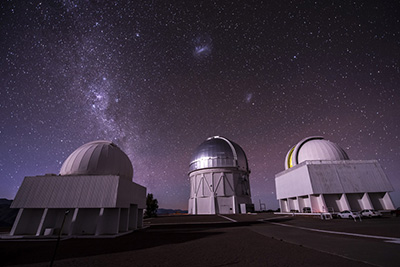
Ordinary matter makes up just 5 percent of the contents of the universe; the remaining 95 percent is made of dark matter and dark energy. Scientists inferred the existence of both of these phenomena by observing their cosmic effects but have yet to directly detect either. Several Fermilab experiments are seeking to uncover the mysteries of the dark universe.
Scientists deduced the existence of dark matter by studying the behavior of galaxies and galaxy clusters. They could not explain the way stars move within galaxies or the way galaxies move within clusters based solely on the amount of visible matter within them. Some additional, unseen mass needs to be exerting a gravitational pull on them. They named that something dark matter.
Dark energy, like dark matter, does not emit light and thus cannot be seen in telescopes, but its properties are otherwise very different from those of dark matter. The universe began expanding at the Big Bang, about 13.8 billion years ago. For the first several billion years, the force of gravity from all of the matter in the universe put the brakes on that expansion, slowing it down. However, in 1998 scientists discovered that the universe is now expanding at an increasing rate: It's been speeding up for the last several billion years. Since matter — including dark matter — would slow the expansion, dark energy cannot be just another form of matter. It is more bizarre than that, hence the name: dark energy.
In the early 1980s, Fermilab scientists were some of the first to bring together the worlds of astrophysics and particle physics into the new field of particle astrophysics, recognizing the powerful connections between the study of matter on very tiny scales in the Fermilab accelerator program ("inner space") and the origin and large-scale evolution of our universe ("outer space"). In 1983, Fermilab began putting together a team of physicists, postdocs and students for its first Theoretical Astrophysics Group. By the end of the decade, Fermilab got involved in testing astrophysics theories by making key contributions to projects such as the Sloan Digital Sky Survey, the Cryogenic Dark Matter Search experiment and the Pierre Auger Observatory.
Fermilab scientists continue to explore this cosmic frontier through a number of experiments.
Dark energy
Dark Energy Survey
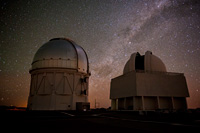
Fermilab leads the Dark Energy Survey, known as DES, which analyzes data obtained with one of the world's largest digital cameras to investigate the nature of dark energy. With their 570-megapixel camera, called the Dark Energy Camera and mounted on the 4-meter Blanco telescope in Chile, DES scientists surveyed about 300 million galaxies in the southern sky. The Dark Energy Camera is one of the most powerful astronomical survey instruments of its kind: In each snapshot, it is able to capture the light from more than 100,000 galaxies up to 8 billion light-years away. DES is one of the largest cosmic surveys ever undertaken, studying galaxy clusters, supernovae, the large-scale clumping of galaxies and weak gravitational lensing. The DES collaboration comprises scientists from 25-plus collaborating institutions from around the world. The collaboration completed its data-taking in early 2019 and continues to analyze data and publish scientific results. DES scientists also spotted the first visible counterpart of gravitational waves ever detected, a collision of two neutron stars that occurred 130 million years ago. DES was one of several sky surveys that detected this gravitational wave source, opening the door to a new kind of astronomy.
Dark Energy Spectroscopic Instrument
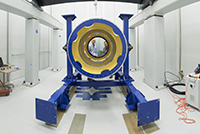 Fermilab is a collaborating member of the Dark Energy Spectroscopic Instrument project, known as DESI. DESI aims to create a 3-D map of one-third of the night sky. The instrument will be attached to the 4-meter Mayall telescope in Arizona and take detailed light measurements from 30 million galaxies over five years, beginning in 2019. This map could help to solve the mystery of dark energy in a way that complements DES (see above) and LSST (see below). DESI will collect light using optical fibers that can be positioned to point precisely at previously identified galaxies. Fermilab is building the barrel that contains the instrument's lenses; packaging and testing the sensors, called CCDs, that convert the light from galaxies into readable signals; developing an online database; and building the software that will tell the fibers exactly where to point.
Fermilab is a collaborating member of the Dark Energy Spectroscopic Instrument project, known as DESI. DESI aims to create a 3-D map of one-third of the night sky. The instrument will be attached to the 4-meter Mayall telescope in Arizona and take detailed light measurements from 30 million galaxies over five years, beginning in 2019. This map could help to solve the mystery of dark energy in a way that complements DES (see above) and LSST (see below). DESI will collect light using optical fibers that can be positioned to point precisely at previously identified galaxies. Fermilab is building the barrel that contains the instrument's lenses; packaging and testing the sensors, called CCDs, that convert the light from galaxies into readable signals; developing an online database; and building the software that will tell the fibers exactly where to point.
LSST
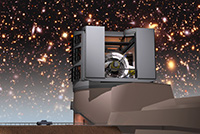 Fermilab is contributing its vast experience in survey operations and data analysis from the Sloan Digital Sky Survey and DES to operation of the Large Synoptic Survey Telescope, or LSST. LSST, which will employ a multigigapixel camera on a new 6.8-meter telescope, is currently under construction in Chile and is expected to begin its 10-year survey in 2022. LSST will survey the entire visible southern sky every few days to advance our understanding of dark energy and dark matter, the Milky Way, the Solar System, and transient phenomena.
Fermilab is contributing its vast experience in survey operations and data analysis from the Sloan Digital Sky Survey and DES to operation of the Large Synoptic Survey Telescope, or LSST. LSST, which will employ a multigigapixel camera on a new 6.8-meter telescope, is currently under construction in Chile and is expected to begin its 10-year survey in 2022. LSST will survey the entire visible southern sky every few days to advance our understanding of dark energy and dark matter, the Milky Way, the Solar System, and transient phenomena.
Dark matter
ADMX
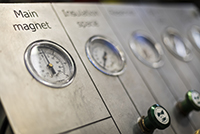
The Axion Dark Matter Experiment (ADMX) brings together scientists from 10 institutions from the United States and UK to hunt for a hypothetical particle called an axion, which may solve the mystery of dark matter. The experiment is managed by Fermilab and housed at the University of Washington. It is the first and only axion dark matter experiment that has achieved the sensitivity necessary to test the predictions for dark matter axions.
LUX-ZEPLIN
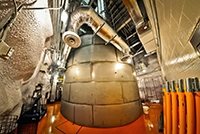
The LUX-ZEPLIN experiment, also known as LZ, searches for dark matter particles in the form of weakly interacting massive particles (WIMPs). The LZ detector consists of seven tons of liquid xenon to detect interactions between dark matter and ordinary matter. Scientists are currently building LZ nearly a mile underground at the Sanford Underground Research Facility in South Dakota. Fermilab is building key parts of the detector in collaboration with Northwestern University and has major scientific roles in the collaboration.
SuperCDMS
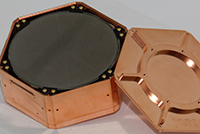
Fermilab has long had a leading role in the SuperCDMS collaboration, which searches for dark matter WIMP interactions with germanium and silicon detectors that can detect very small energy depositions. CDMS experiments at the Soudan underground laboratory in northern Minnesota were trailblazers in the search for dark matter. SuperCDMS SNOLAB, a new experiment to search for low-mass dark matter particles, is under construction at the SNOLAB underground laboratory in the Sudbury mine, Ontario, Canada. Fermilab scientists are playing key leadership roles in the new experiment.
SENSEI
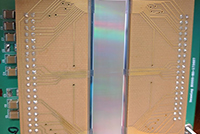
Fermilab, in collaboration with Lawrence Berkeley National Laboratory, recently led the development of the skipper CCD, a breakthrough technology with unprecedented sensitivity for ultralow-energy particle detection. Fermilab is now collaborating with Stonybrook University to demonstrate the potential of this technology as a low-mass dark matter experiment, called SENSEI, and has attracted external funding from the Heising-Simons Foundation.
Cosmic microwave background
SPT-3G
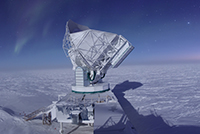
The South Pole Telescope measures the cosmic microwave background, or CMB, light left over from the Big Bang. Fermilab led the design of major components and housed the integration and testing facility of the new, third-generation, highly sensitive camera that was deployed to the South Pole in 2017. The new camera will enable scientists to map the mass density of the universe through measurements of CMB lensing, the bending of light caused by immense objects such as clusters of galaxies. These measurements will help determine the masses of neutrinos, elusive but pervasive, mysterious particles. The experiment will also search for the polarization pattern imprinted by a primordial epoch of cosmic acceleration known as inflation. Since deployment, Fermilab scientists are filling major roles in the operations of SPT-3G, in close collaboration with the University of Chicago and Argonne National Laboratory.
- Last modified
- 04/27/2020
- email Fermilab

